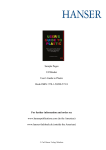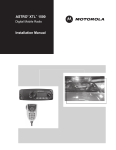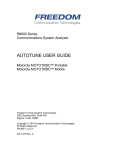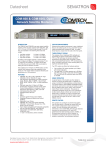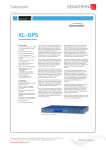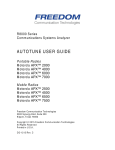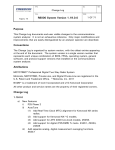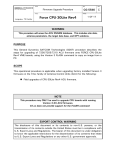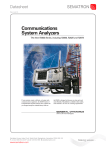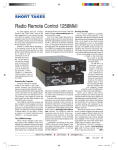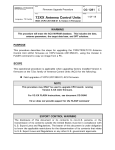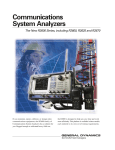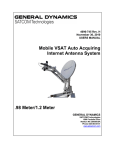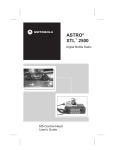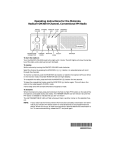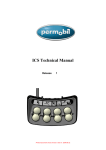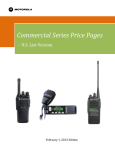Download User Guide
Transcript
User Guide Rev A. Sept 11. R8000 Series Communications Systems Analyzer AUTOTUNE USER GUIDE Motorola ASTRO® XTL™ Series Motorola ASTRO® XTS™ 5000 Motorola ASTRO® XTS™ 2500 General Dynamics SATCOM Technologies 3750 W. Loop 281 Longview, Texas 75604 Copyright 2011 General Dynamics All Rights Reserved Printed in U.S.A. CG-xxxx Rev. A Sandpiper House, Aviary Court, Wade Road, Basingstoke, Hampshire, RG24 8GX, UK T +44 (0) 1256 812 222 F +44 (0) 1256 812 666 E [email protected] www.sematron.com Making waves... User Guide Rev A. Sept 11. AutoTune™ User Guide AUTOTUNE™ SOFTWARE LICENSE AGREEMENT The software license agreement governing use of the R8000 Series Communications Systems Analyzer AutoTune™ software is located in CG-1365 R8000 Series Communications Systems Analyzer Operator’s Manual. TRADEMARKS The General Dynamics SATCOM Technologies logo and General Dynamics SATCOM Technologies are registered ® trademarks of General Dynamics SATCOM Technologies. MOTOROLA is registered in the U.S. Patent and Trademark Office. All other product and service names are the property of their registered owners. © 2000-2004 by Motorola, Inc. All rights reserved. i Sandpiper House, Aviary Court, Wade Road, Basingstoke, Hampshire, RG24 8GX, UK T +44 (0) 1256 812 222 F +44 (0) 1256 812 666 E [email protected] www.sematron.com Making waves... User Guide Rev A. Sept 11. AutoTune™ User Guide TABLE OF CONTENTS 1. 2. 3. Introduction ....................................................................................................1 Scope ............................................................................................................1 Motorola ASTRO® XTL™ Series Radio Test Setup ......................................2 3.1. ASTRO® XTL™ Series Test Setup ........................................................2 4. Motorola ASTRO® XTL™ Series Alignment and Test Descriptions ..............3 4.1. Reference Frequency .............................................................................3 4.2. TX Power Out .........................................................................................5 4.3. Deviation Balance...................................................................................7 4.4. Deviation Limit ........................................................................................8 4.5. Distortion ................................................................................................9 4.6. Sensitivity (SINAD) ...............................................................................10 4.7. Noise Squelch Threshold......................................................................11 4.8. Digital Sensitivity (BER)........................................................................12 4.9. Ext Mic Voice Modulation .....................................................................13 5. Motorola ASTRO® XTS™ 5000 Radio Test Setup......................................15 5.1. ASTRO® XTS™ 5000 Test Setup........................................................15 6. Motorola ASTRO® XTS™ 5000 Alignment and Test Descriptions..............16 6.1. Reference Frequency ...........................................................................16 6.2. TX Power Out .......................................................................................18 6.3. Deviation Balance.................................................................................19 6.4. Deviation Limit ......................................................................................20 6.5. Distortion ..............................................................................................21 6.6. Sensitivity (SINAD) ...............................................................................22 6.7. Noise Squelch Threshold......................................................................23 6.8. Digital Sensitivity (BER)........................................................................24 6.9. Internal Voice Modulation .....................................................................25 6.10. External Voice Modulation ................................................................27 7. Motorola ASTRO® XTS™ 2500 Test Setup ................................................28 8. Motorola ASTRO® XTS™ 2500 Alignment and Test Descriptions..............29 8.1. Reference Frequency ...........................................................................29 8.2. TX Power Out .......................................................................................31 8.3. Deviation Balance.................................................................................32 8.4. Deviation Limit ......................................................................................33 8.5. Distortion ..............................................................................................34 8.6. Sensitivity (SINAD) ...............................................................................35 8.7. Noise Squelch Threshold......................................................................36 8.8. Digital Sensitivity (BER)........................................................................37 8.9. Internal Voice Modulation .....................................................................38 8.10. External Voice Modulation ................................................................40 9. Basic Troubleshooting .................................................................................41 10. Support Information .....................................................................................42 10.1. Technical Support .............................................................................42 ii Sandpiper House, Aviary Court, Wade Road, Basingstoke, Hampshire, RG24 8GX, UK T +44 (0) 1256 812 222 F +44 (0) 1256 812 666 E [email protected] www.sematron.com Making waves... User Guide Rev A. Sept 11. AutoTune™ User Guide 10.2. Sales Support ...................................................................................42 11. References ..................................................................................................43 APPENDIX A. Test Limits ............................................................................ A-1 APPENDIX B. Sample Test Result Report .................................................. B-1 APPENDIX C. Revision History ................................................................... C-1 LIST OF FIGURES Figure 3-1. ASTRO® XTL™ Series Mid Power Test Setup Diagram...................2 Figure 4-1. Place keyed microphone next to analyzer speaker. .........................14 Figure 4-2. Adjust analyzer volume until about 4 kHz deviation is measured. ....14 Figure 5-1. ASTRO® XTS™ 5000 Test Setup Diagram ....................................15 Figure 6-1. Place keyed radio next to analyzer speaker. ....................................25 Figure 6-2. Adjust analyzer volume until about 4 kHz deviation is measured. ....26 Figure 7-1. ASTRO® XTS™ 2500 Test Setup Diagram ....................................28 Figure 8-1. Place keyed radio next to analyzer speaker. ....................................38 Figure 8-2. Adjust analyzer volume until about 4 kHz deviation is measured. ....39 Figure B-1. Sample Test Result Report ............................................................ B-1 iii Sandpiper House, Aviary Court, Wade Road, Basingstoke, Hampshire, RG24 8GX, UK T +44 (0) 1256 812 222 F +44 (0) 1256 812 666 E [email protected] www.sematron.com Making waves... User Guide Rev A. Sept 11. AutoTune™ User Guide LIST OF TABLES Table 4-1. Analyzer Configuration for Reference Frequency ................................3 Table 4-2. Reference Frequency alignment results ..............................................3 Table 4-3. Reference Frequency test results ........................................................4 Table 4-4. Analyzer Configuration for TX Power Out ............................................5 Table 4-5. Power Detection Calibration alignment results ....................................5 Table 4-6. TX Power Out alignment results ..........................................................5 Table 4-7. TX Power Out test results ....................................................................6 Table 4-8. Analyzer Configuration for Deviation Balance test, alignment .............7 Table 4-9. Deviation Balance alignment results ....................................................7 Table 4-10. Deviation Balance test results............................................................7 Table 4-11. Analyzer Configuration for Deviation Limit .........................................8 Table 4-12. Deviation Limit alignment results .......................................................8 Table 4-13. Deviation Limit test results .................................................................8 Table 4-14. Analyzer Configuration for Distortion Test .........................................9 Table 4-15. Distortion test results .........................................................................9 Table 4-16. Analyzer Configuration for Sensitivity (SINAD) test .........................10 Table 4-17. Sensitivity (SINAD) test results ........................................................10 Table 4-18. Analyzer Configuration for Noise Squelch Threshold test................11 Table 4-19. Noise Squelch Threshold test results ..............................................11 Table 4-20. Analyzer Configuration for Digital Sensitivity (BER) test ..................12 Table 4-21. Digital Sensitivity (BER) test results.................................................12 Table 4-22. Analyzer Configuration for Ext Mic Voice Modulation test................13 Table 4-23. Ext Mic Voice Modulation test results ..............................................13 Table 6-1. Analyzer Configuration for Reference Frequency ..............................16 Table 6-2. Reference Frequency alignment results ............................................16 Table 6-3. Reference Frequency test results ......................................................17 Table 6-4. Analyzer Configuration for TX Power Out ..........................................18 Table 6-5. TX Power Out alignment results ........................................................18 Table 6-6. TX Power Out test results ..................................................................18 Table 6-7. Analyzer Configuration for Deviation Balance test, alignment ...........19 Table 6-8. Deviation Balance alignment results ..................................................19 Table 6-9. Deviation Balance test results............................................................19 Table 6-10. Analyzer Configuration for Deviation Limit .......................................20 Table 6-11. Deviation Limit alignment results .....................................................20 Table 6-12. Deviation Limit test results ...............................................................20 Table 6-13. Analyzer Configuration for Distortion Test .......................................21 Table 6-14. Distortion test results .......................................................................21 Table 6-15. Analyzer Configuration for Sensitivity (SINAD) test .........................22 Table 6-16. Sensitivity (SINAD) test results ........................................................22 Table 6-17. Analyzer Configuration for Noise Squelch Threshold test................23 Table 6-18. Noise Squelch Threshold test results ..............................................23 Table 6-19. Analyzer Configuration for Digital Sensitivity (BER) test ..................24 Table 6-20. Digital Sensitivity (BER) test results.................................................24 Table 6-21. Analyzer Configuration for Internal Voice Modulation test ...............25 iv Sandpiper House, Aviary Court, Wade Road, Basingstoke, Hampshire, RG24 8GX, UK T +44 (0) 1256 812 222 F +44 (0) 1256 812 666 E [email protected] www.sematron.com Making waves... User Guide Rev A. Sept 11. AutoTune™ User Guide Table 6-22. Internal Voice Modulation test results ..............................................25 Table 6-23. Analyzer Configuration for External Voice Modulation test ..............27 Table 6-24. External Voice Modulation test results .............................................27 Table 8-1. Analyzer Configuration for Reference Frequency ..............................29 Table 8-2. Reference Frequency alignment results ............................................29 Table 8-3. Reference Frequency test results ......................................................30 Table 8-4. Analyzer Configuration for TX Power Out ..........................................31 Table 8-5. TX Power Out alignment results ........................................................31 Table 8-6. TX Power Out test results ..................................................................31 Table 8-7. Analyzer Configuration for Deviation Balance test, alignment ...........32 Table 8-8. Deviation Balance alignment results ..................................................32 Table 8-9. Deviation Balance test results............................................................32 Table 8-10. Analyzer Configuration for Deviation Limit .......................................33 Table 8-11. Deviation Limit alignment results .....................................................33 Table 8-12. Deviation Limit test results ...............................................................33 Table 8-13. Analyzer Configuration for Distortion Test .......................................34 Table 8-14. Distortion test results .......................................................................34 Table 8-15. Analyzer Configuration for Sensitivity (SINAD) test .........................35 Table 8-16. Sensitivity (SINAD) test results ........................................................35 Table 8-17. Analyzer Configuration for Noise Squelch Threshold test................36 Table 8-18. Noise Squelch Threshold test results ..............................................36 Table 8-19. Analyzer Configuration for Digital Sensitivity (BER) test ..................37 Table 8-20. Digital Sensitivity (BER) test results.................................................37 Table 8-21. Analyzer Configuration for Internal Voice Modulation test ...............38 Table 8-22. Internal Voice Modulation test results ..............................................38 Table 8-23. Analyzer Configuration for External Voice Modulation test ..............40 Table 8-24. External Voice Modulation test results .............................................40 Table 9-1. AutoTune Troubleshooting Chart.......................................................41 Table A-1. Default Motorola ASTRO® XTL™ Series Limits.............................. A-3 Table A-2. Default Motorola ASTRO® XTS™ 5000 Limits ............................... A-5 Table A-3. Default Motorola ASTRO® XTS™ 2500 Limits ............................... A-7 v Sandpiper House, Aviary Court, Wade Road, Basingstoke, Hampshire, RG24 8GX, UK T +44 (0) 1256 812 222 F +44 (0) 1256 812 666 E [email protected] www.sematron.com Making waves... User Guide Rev A. Sept 11. AutoTune™ User Guide 1. Introduction The General Dynamics R8000 Series Communications Systems Analyzer AutoTune™ (hereafter “AutoTune”) is designed to provide an automated test and alignment solution for supported two-way radios. 2. Scope This document is intended to provide information regarding the tests and alignments performed for supported radios by AutoTune. This document is restricted to radiospecific information. Please refer to the R8000 Series Communications System Analyzer Owner’s Manual (CG-1365) for an overview and basic operating instructions for AutoTune itself. 1 Sandpiper House, Aviary Court, Wade Road, Basingstoke, Hampshire, RG24 8GX, UK T +44 (0) 1256 812 222 F +44 (0) 1256 812 666 E [email protected] www.sematron.com Making waves... User Guide Rev A. Sept 11. AutoTune™ User Guide 3. Motorola ASTRO® XTL™ Series Radio Test Setup In order to perform the test and alignment procedures, the ASTRO® XTL™ Series radio must be connected to the R8000 Communications Systems Analyzer as shown in the figure below. Use of HKN6163_ USB radio programming cable as indicated is required to perform all tests. Use of other GCAI USB radio programming cables is not currently supported. Make certain that the radio under test is configured as described in the corresponding diagram before attempting to perform an alignment or test. Failure to do so may result in poor radio performance and/or damage to the analyzer or radio equipment under test. 3.1. ASTRO® XTL™ Series Test Setup Refer to the diagram below for the proper test setup. Figure 3-1. ASTRO® XTL™ Series Mid Power Test Setup Diagram 2 Sandpiper House, Aviary Court, Wade Road, Basingstoke, Hampshire, RG24 8GX, UK T +44 (0) 1256 812 222 F +44 (0) 1256 812 666 E [email protected] www.sematron.com Making waves... User Guide Rev A. Sept 11. AutoTune™ User Guide 4. Motorola ASTRO® XTL™ Series Alignment and Test Descriptions Note: Throughout this section are references to Test Frequency. Test Frequencies that are band- and mode -specific. A table of the frequencies used by each band may be found in the respective radio service manual. See the References section for more details. Note: All analyzer Mode settings are Standard unless otherwise indicated. 4.1. Reference Frequency RF Control Monitor Port RF IN/OUT Frequency Test Frequency Modulation Attenuation FM 20 dB Table 4-1. Analyzer Configuration for Reference Frequency 4.1.1. Alignment The radio is placed into Test Mode at the highest TX Test Frequency and commanded to transmit. Using a best linear fit algorithm, two frequency error measurements are taken at two different radio softpot values. These frequency error measurements are used to calculate the softpot value which minimizes frequency error. After programming this new softpot value into the radio, the radio softpot is fine tuned until minimum frequency error is detected. The frequency error is compared against test limits and the final results written to the log file. Name Result Frequency Freq Error Min Limit Max Limit Old Softpot New Softpot Description Pass or Fail. Frequency Error within Max Limit, Min Limit Test Frequency Measured frequency error after alignment Minimum Limit (inclusive) for frequency error Maximum Limit (inclusive) for frequency error Original radio softpot setting Radio softpot after alignment Table 4-2. Reference Frequency alignment results 4.1.2. Test The radio is placed into Test Mode at the highest TX Test Frequency and commanded to transmit. The frequency error is measured by the analyzer and compared to test limits. The final results are written to the log file. 3 Sandpiper House, Aviary Court, Wade Road, Basingstoke, Hampshire, RG24 8GX, UK T +44 (0) 1256 812 222 F +44 (0) 1256 812 666 E [email protected] www.sematron.com Making waves... User Guide Rev A. Sept 11. AutoTune™ User Guide Name Result Frequency Freq Error Max Limit Min Limit Softpot Description Pass or Fail. Frequency Error within Max Limit, Min Limit Test Frequency Measured frequency error Maximum Limit (inclusive) for frequency error Minimum Limit (inclusive) for frequency error Radio softpot which yields Freq Error Table 4-3. Reference Frequency test results 4 Sandpiper House, Aviary Court, Wade Road, Basingstoke, Hampshire, RG24 8GX, UK T +44 (0) 1256 812 222 F +44 (0) 1256 812 666 E [email protected] www.sematron.com Making waves... User Guide Rev A. Sept 11. AutoTune™ User Guide 4.2. TX Power Out RF Control Monitor Port RF IN/OUT Frequency Test Frequency Table 4-4. Analyzer Configuration for TX Power Out Modulation Attenuation FM 40 dB 4.2.1. Alignment The TX Power Out alignment is composed of two parts: Power Detection Calibration and TX Power Out. Power Detection Calibration is performed first, and only during alignment; it is not performed during a test. Power Detector Calibration adjusts the radio power detector to minimize the power output variation across radios. The radio is placed into Test Mode and commanded to transmit at a mid-band Test Frequency. The output level is measured and then adjusted until near to a band-specific output level defined by the radio itself. The final results are written to the log file. Name Result Frequency Meas Power Target Power Old Softpot New Softpot Description Pass or Fail. Meas Power AND New Softpot within manufacturer limits Test Frequency Measured radio output level Ideal Meas Power Original radio softpot setting Radio softpot after alignment Table 4-5. Power Detection Calibration alignment results TX Power Out characterizes the power output level of the radio. The radio is placed into Test Mode and commanded to transmit. Beginning at the lowest TX Test Frequency, the output level is measured at two different points for each TX Test Frequency. These measurements are used to align the radio power output level across the radio band as specified by the radio basic service manual. After the alignment is complete, the power output level is measured again at each TX Test Frequency and compared against test limits. The final results are written to the log file. Name Result Frequency Power Out Min Limit Max Limit Description Pass or Fail. Power Out within Max Limit, Min Limit Test Frequency Measured radio output level Minimum Limit (inclusive) for Power Out Maximum Limit (inclusive) for Power Out Table 4-6. TX Power Out alignment results 5 Sandpiper House, Aviary Court, Wade Road, Basingstoke, Hampshire, RG24 8GX, UK T +44 (0) 1256 812 222 F +44 (0) 1256 812 666 E [email protected] www.sematron.com Making waves... User Guide Rev A. Sept 11. AutoTune™ User Guide 4.2.2. Test The radio is placed into Test Mode and commanded to transmit. Beginning at the lowest TX Test Frequency, the output level is measured at each TX Test Frequency and compared against test limits. The final results are written to the log file. Name Result Frequency Power Out Min Limit Max Limit Description Pass or Fail. Power Out within Max Limit, Min Limit Test Frequency Measured radio output level Minimum Limit (inclusive) for Power Out Maximum Limit (inclusive) for Power Out Table 4-7. TX Power Out test results 6 Sandpiper House, Aviary Court, Wade Road, Basingstoke, Hampshire, RG24 8GX, UK T +44 (0) 1256 812 222 F +44 (0) 1256 812 666 E [email protected] www.sematron.com Making waves... User Guide Rev A. Sept 11. AutoTune™ User Guide 4.3. Deviation Balance RF Control Monitor Port RF IN/OUT Frequency Test Frequency Modulation Attenuation FM 20 dB Table 4-8. Analyzer Configuration for Deviation Balance test, alignment 4.3.1. Alignment The radio is placed into Test Mode at the highest TX Test Frequency and commanded to transmit. The radio generates an 80 Hz modulation tone and the deviation of this tone is measured with the analyzer. The radio then generates a 3 kHz modulation tone and the deviation of this tone is measured with the analyzer. The radio softpot is adjusted until the deviation difference between the first and second tones is within test limits. This adjustment is performed for each TX Test Frequency and the percent difference is compared against test limits. The results for each TX Test Frequency are written to the log file. Name Result Frequency Variance Max Limit Old Softpot New Softpot Description Pass or Fail. Percent difference between low and high tone deviation less than or equal to Variance. Test Frequency Measured difference between low and high tone deviation Maximum passable percent difference (inclusive) between low and high tone deviation Original radio softpot setting Radio softpot setting after alignment Table 4-9. Deviation Balance alignment results 4.3.2. Test The radio is placed into Test Mode at the highest TX Test Frequency and commanded to transmit. The radio generates an 80 Hz modulation tone and the deviation of this tone is measured with the analyzer. The radio then generates a 3 kHz modulation tone and the deviation of this tone is measured with the analyzer. The percent difference is compared against test limits and written to the log file. This test is performed for each remaining TX Test Frequency. Name Result Frequency Variance Max Limit Description Pass or Fail. Percent difference between low and high tone deviation less than or equal to Variance. Test Frequency Measured difference between low and high tone deviation Maximum passable percent difference (inclusive) between low and high tone deviation Table 4-10. Deviation Balance test results 7 Sandpiper House, Aviary Court, Wade Road, Basingstoke, Hampshire, RG24 8GX, UK T +44 (0) 1256 812 222 F +44 (0) 1256 812 666 E [email protected] www.sematron.com Making waves... User Guide Rev A. Sept 11. AutoTune™ User Guide 4.4. Deviation Limit RF Control Monitor Port RF IN/OUT Frequency Test Frequency Table 4-11. Analyzer Configuration for Deviation Limit Modulation FM Level 20 dB 4.4.1. Alignment The radio is placed into Test Mode at the highest TX Test Frequency and commanded to transmit. The radio generates a digital test pattern at high deviation. This deviation is measured with the analyzer and adjusted until it is close to the midpoint between the test limits. The resulting deviation measurement is compared against test limits and written to the log file. This adjustment is repeated for each remaining TX Test Frequency. Name Result Frequency Deviation Min Limit Max Limit Old Softpot New Softpot Description Pass or Fail. Deviation level within Max Limit, Min Limit Test Frequency Measured deviation level Minimum Limit (inclusive) for Deviation Maximum Limit (inclusive) for Deviation Original radio softpot setting Radio softpot after alignment Table 4-12. Deviation Limit alignment results 4.4.2. Test The radio is placed into Test Mode at the highest TX Test Frequency and commanded to transmit. The radio generates a digital test pattern at high deviation. This deviation is measured and compared against test limits. The final results are written to the log file. This test is repeated for each remaining TX Test Frequency. Name Result Frequency Deviation Min Limit Max Limit Description Pass or Fail. Deviation level within Max Limit, Min Limit Test Frequency Measured deviation level Minimum Limit (inclusive) for Deviation Maximum Limit (inclusive) for Deviation Table 4-13. Deviation Limit test results 8 Sandpiper House, Aviary Court, Wade Road, Basingstoke, Hampshire, RG24 8GX, UK T +44 (0) 1256 812 222 F +44 (0) 1256 812 666 E [email protected] www.sematron.com Making waves... User Guide Rev A. Sept 11. AutoTune™ User Guide 4.5. Distortion This is a test only; there is no alignment. RF Control Generate Port RF IN/OUT Frequency Test Freq Modulation FM, 1 kHz @ 3 kHz deviation Table 4-14. Analyzer Configuration for Distortion Test Level -50 dBm 4.5.1. Alignment No alignment is needed. 4.5.2. Test The analyzer is setup as specified in this section’s Analyzer Configuration table. The radio is placed into Test Mode at the lowest RX Test Frequency. The radio audio output level is tested and if insufficient to measure distortion the volume is increased until sufficient to measure distortion. The audio signal’s distortion level is then measured and compared to test limits. The final results are written to the log file. Name Result Frequency Distortion Max Limit Description Pass or Fail. Distortion level within Max Limit, Min Limit Test Frequency Measured audio signal distortion level Maximum Limit (inclusive) for Distortion to Pass Table 4-15. Distortion test results 9 Sandpiper House, Aviary Court, Wade Road, Basingstoke, Hampshire, RG24 8GX, UK T +44 (0) 1256 812 222 F +44 (0) 1256 812 666 E [email protected] www.sematron.com Making waves... User Guide Rev A. Sept 11. AutoTune™ User Guide 4.6. Sensitivity (SINAD) This is a test only; there is no alignment. RF Control Generate Port RF IN/OUT Frequency Test Freq Modulation FM, 1 kHz @ 3kHz deviation Table 4-16. Analyzer Configuration for Sensitivity (SINAD) test Level -50 dBm 4.6.1. Alignment No alignment is needed. 4.6.2. Test The analyzer is setup as specified in this section’s Analyzer Configuration table. The radio is placed into Test Mode at the lowest RX Test Frequency. The radio audio output level is tested and if insufficient to measure SINAD the volume is increased until sufficient to measure SINAD. The output level of the analyzer is then adjusted until the radio audio signal’s SINAD level measures about 12 dB. The current analyzer output level is then compared against test limits. The final results are written to the log file. Name Result Frequency 12dB SINAD Max Limit Description Pass or Fail. Sensitivity (SINAD) level within Max Limit Test Frequency Analyzer output level at which the radio SINAD level measures 12 dB Maximum Limit (inclusive) for Sensitivity (SINAD) to Pass Table 4-17. Sensitivity (SINAD) test results 10 Sandpiper House, Aviary Court, Wade Road, Basingstoke, Hampshire, RG24 8GX, UK T +44 (0) 1256 812 222 F +44 (0) 1256 812 666 E [email protected] www.sematron.com Making waves... User Guide Rev A. Sept 11. AutoTune™ User Guide 4.7. Noise Squelch Threshold This is a test only; there is no alignment. RF Control Generate Port RF IN/OUT Frequency Test Freq Modulation FM, 1 kHz @ 3kHz deviation Table 4-18. Analyzer Configuration for Noise Squelch Threshold test Level -50 dBm 4.7.1. Alignment No alignment is needed. 4.7.2. Test The purpose of this procedure is to verify that the squelch circuit operation performs as expected, blocking noise but allowing stronger signals to be heard. The analyzer is setup as specified in this section’s Analyzer Configuration table. The radio is placed into Test Mode at the lowest RX Test Frequency. The radio audio output level is tested and if insufficient to measure the unsquelched condition the volume is increased. Beginning at -125 dBm, the analyzer output level is slowly increased until the radio unsquelches OR is 6 dBm above the Max Limit, whichever comes first. The Unsquelch analyzer output level is compared against test limits and the final results written to the log file. Name Result Frequency Unsquelch Max Limit Description Pass or Fail. Noise Squelch Threshold level within Max Limit Test Frequency Analyzer output level at which the radio unsquelches Maximum Limit (exclusive) for Noise Squelch Threshold to Pass Table 4-19. Noise Squelch Threshold test results 11 Sandpiper House, Aviary Court, Wade Road, Basingstoke, Hampshire, RG24 8GX, UK T +44 (0) 1256 812 222 F +44 (0) 1256 812 666 E [email protected] www.sematron.com Making waves... User Guide Rev A. Sept 11. AutoTune™ User Guide 4.8. Digital Sensitivity (BER) NOTE: This test requires an analyzer with P25 Conventional test mode capability. The purpose of this procedure is to measure the radio receiver’s Bit Error Rate at a given frequency. The TIA/EIA standard BER rate is 5%. This is a test only; there is no alignment. RF Control Generate Port RF IN/OUT Frequency Test Frequency Modulation Framed 1011 Hz Pattern, 2.83 kHz deviation Level -116.0 dBm Table 4-20. Analyzer Configuration for Digital Sensitivity (BER) test 4.8.1. Alignment No alignment is needed. 4.8.2. Test The analyzer is setup as specified in this section’s Analyzer Configuration table. The radio is placed into Test Mode at the lowest RX Test Frequency, ready to receive a C4FM-modulated signal from the analyzer. Once BER synchronization is detected, the analyzer output level is decreased until a BER of 5% is measured. The analyzer output level at 5% BER is compared against test limits and the final results are written to the log file. Name Result Frequency 5% BER Max Limit Description Pass or Fail. Digital Sensitivity (BER) output level within Max Limit Test Frequency Analyzer output level at which the radio BER measures 5% Maximum Limit (inclusive) for Digital Sensitivity (BER) to Pass Table 4-21. Digital Sensitivity (BER) test results 12 Sandpiper House, Aviary Court, Wade Road, Basingstoke, Hampshire, RG24 8GX, UK T +44 (0) 1256 812 222 F +44 (0) 1256 812 666 E [email protected] www.sematron.com Making waves... User Guide Rev A. Sept 11. AutoTune™ User Guide 4.9. Ext Mic Voice Modulation The purpose of this procedure is to test the ability of the radio’s external microphone audio circuit to accurately transfer the received microphone signal. RF Control Monitor Port RF IN/OUT Frequency Test Frequency Modulation FM Name Result Frequency Deviation Min Limit Max Limit Description Pass or Fail. Deviation within Min Limit, Max Limit Test Frequency Measured modulation deviation level Minimum Limit (inclusive) for Deviation to Pass Maximum Limit (inclusive) for Deviation to Pass Table 4-22. Analyzer Configuration for Ext Mic Voice Modulation test Attenuation 40 dB Table 4-23. Ext Mic Voice Modulation test results 4.9.1. Alignment No alignment is needed. 4.9.2. Test The radio is placed into Test Mode at the lowest TX Test Frequency. The analyzer is setup as specified in this section’s Analyzer Configuration table. The user is instructed to key the connected radio microphone and place the microphone next to the analyzer speaker (see Figure 4-1). The user is also instructed to adjust the analyzer volume until about 4 kHz deviation is seen on the analyzer display (see Figure 4-2). The deviation level is then measured by the analyzer and the user is instructed when to un-key the microphone. The measured deviation is compared against test limits and the final results are written to the log file. 13 Sandpiper House, Aviary Court, Wade Road, Basingstoke, Hampshire, RG24 8GX, UK T +44 (0) 1256 812 222 F +44 (0) 1256 812 666 E [email protected] www.sematron.com Making waves... User Guide Rev A. Sept 11. AutoTune™ User Guide Figure 4-1. Place keyed microphone next to analyzer speaker. Figure 4-2. Adjust analyzer volume until about 4 kHz deviation is measured. 14 Sandpiper House, Aviary Court, Wade Road, Basingstoke, Hampshire, RG24 8GX, UK T +44 (0) 1256 812 222 F +44 (0) 1256 812 666 E [email protected] www.sematron.com Making waves... User Guide Rev A. Sept 11. AutoTune™ User Guide 5. Motorola ASTRO® XTS™ 5000 Radio Test Setup In order to perform the test and alignment procedures, the ASTRO® XTL™ Series radio must be connected to the R8000 Communications Systems Analyzer as shown in the figure below. Make certain that the radio under test is configured as described in the corresponding diagram before attempting to perform the indicated alignment or test. Failure to do so may result in poor radio performance and/or damage to the analyzer or radio equipment under test. 5.1. ASTRO® XTS™ 5000 Test Setup Refer to the diagram below for the proper test setup. Note that the correct setting for each RLN4460 test set control is highlighted in yellow. Figure 5-1. ASTRO® XTS™ 5000 Test Setup Diagram 15 Sandpiper House, Aviary Court, Wade Road, Basingstoke, Hampshire, RG24 8GX, UK T +44 (0) 1256 812 222 F +44 (0) 1256 812 666 E [email protected] www.sematron.com Making waves... User Guide Rev A. Sept 11. AutoTune™ User Guide 6. Motorola ASTRO® XTS™ 5000 Alignment and Test Descriptions Note: Throughout this section are references to Test Frequency that are band- and mode -specific. A table of the frequencies used by each band may be found in the respective radio service manual. See the References section for more details. Note: All analyzer Mode settings are Standard unless otherwise indicated. 6.1. Reference Frequency RF Control Monitor Port RF IN/OUT Frequency Test Frequency Modulation Attenuation FM 20 dB Table 6-1. Analyzer Configuration for Reference Frequency 6.1.1. Alignment The radio is placed into Test Mode at the highest TX Test Frequency and commanded to transmit. Using a best linear fit algorithm, two frequency error measurements are taken at two different radio softpot values. These frequency error measurements are used to calculate the softpot value which minimizes frequency error. After programming this new softpot value into the radio, the radio softpot is fine tuned until minimum frequency error is detected. The frequency error is compared against test limits and the final results written to the log file. Name Result Frequency Freq Error Min Limit Max Limit Old Softpot New Softpot Description Pass or Fail. Frequency Error within Max Limit, Min Limit Test Frequency Measured frequency error after alignment Minimum Limit (inclusive) for frequency error Maximum Limit (inclusive) for frequency error Original radio softpot setting Radio softpot after alignment Table 6-2. Reference Frequency alignment results 6.1.2. Test The radio is placed into Test Mode at the highest TX Test Frequency and commanded to transmit. The frequency error is measured by the analyzer and compared to test limits. The final results are written to the log file. 16 Sandpiper House, Aviary Court, Wade Road, Basingstoke, Hampshire, RG24 8GX, UK T +44 (0) 1256 812 222 F +44 (0) 1256 812 666 E [email protected] www.sematron.com Making waves... User Guide Rev A. Sept 11. AutoTune™ User Guide Name Result Frequency Freq Error Min Limit Max Limit Softpot Description Pass or Fail. Frequency Error within Max Limit, Min Limit Test Frequency Measured frequency error Minimum Limit (inclusive) for frequency error Maximum Limit (inclusive) for frequency error Radio softpot which yields Freq Error Table 6-3. Reference Frequency test results 17 Sandpiper House, Aviary Court, Wade Road, Basingstoke, Hampshire, RG24 8GX, UK T +44 (0) 1256 812 222 F +44 (0) 1256 812 666 E [email protected] www.sematron.com Making waves... User Guide Rev A. Sept 11. AutoTune™ User Guide 6.2. TX Power Out RF Control Monitor Port RF IN/OUT Frequency Test Frequency Table 6-4. Analyzer Configuration for TX Power Out Modulation Attenuation FM 30 dB 6.2.1. Alignment TX Power Out aligns the power output level of the radio. The radio is placed into Test Mode and commanded to transmit. Beginning at the highest TX Test Frequency and Low power setting, the output level is measured and then adjusted until about midway between the two test limits. The sequence is repeated twice more, for Mid and High power settings, at all Test Frequencies. The final results are written to the log file. Name Result Frequency Power Out Min Limit Max Limit Old Softpot New Softpot Description Pass or Fail. Power Out within Max Limit, Min Limit Test Frequency Measured radio output level Minimum Limit (inclusive) for Power Out Maximum Limit (inclusive) for Power Out Original radio softpot setting Radio softpot setting after alignment Table 6-5. TX Power Out alignment results 6.2.2. Test TX Power Out tests the power output level of the radio. The radio is placed into Test Mode and commanded to transmit. Beginning at the highest TX Test Frequency and Low power setting, the output level is measured at each TX Test Frequency and compared against test limits. The sequence is repeated twice more, for Mid and High power settings, at all Test Frequencies. The final results for all power levels and Test Frequencies are written to the log file. Name Result Frequency Power Out Min Limit Max Limit Softpot Description Pass or Fail. Power Out within Max Limit, Min Limit Test Frequency Measured radio output level Minimum Limit (inclusive) for Power Out Maximum Limit (inclusive) for Power Out Radio softpot setting Table 6-6. TX Power Out test results 18 Sandpiper House, Aviary Court, Wade Road, Basingstoke, Hampshire, RG24 8GX, UK T +44 (0) 1256 812 222 F +44 (0) 1256 812 666 E [email protected] www.sematron.com Making waves... User Guide Rev A. Sept 11. AutoTune™ User Guide 6.3. Deviation Balance RF Control Monitor Port RF IN/OUT Frequency Test Frequency Modulation Attenuation FM 30 dB Table 6-7. Analyzer Configuration for Deviation Balance test, alignment 6.3.1. Alignment The radio is placed into Test Mode at the highest TX Test Frequency and commanded to transmit. The radio generates an 80 Hz modulation tone and the deviation of this tone is measured with the analyzer. The radio then generates a 3 kHz modulation tone and the deviation of this tone is measured with the analyzer. The radio softpot is adjusted until the deviation difference between the first and second tones is within test limits. This adjustment is performed for each TX Test Frequency and the percent difference is compared against test limits. The results for each TX Test Frequency are written to the log file. Name Result Frequency Variance Max Limit Old Softpot New Softpot Description Pass or Fail. Percent difference between low and high tone deviation less than or equal to Variance. Test Frequency Measured difference between low and high tone deviation Maximum passable percent difference (inclusive) between low and high tone deviation Original radio softpot setting Radio softpot setting after alignment Table 6-8. Deviation Balance alignment results 6.3.2. Test The radio is placed into Test Mode at the highest TX Test Frequency and commanded to transmit. The radio generates an 80 Hz modulation tone and the deviation of this tone is measured with the analyzer. The radio then generates a 3 kHz modulation tone and the deviation of this tone is measured with the analyzer. The percent difference is compared against test limits and written to the log file. This test is performed for each remaining TX Test Frequency. Name Result Frequency Variance Max Limit Softpot Description Pass or Fail. Percent difference between low and high tone deviation less than or equal to Variance. Test Frequency Measured difference between low and high tone deviation Maximum passable percent difference (inclusive) between low and high tone deviation Radio softpot setting Table 6-9. Deviation Balance test results 19 Sandpiper House, Aviary Court, Wade Road, Basingstoke, Hampshire, RG24 8GX, UK T +44 (0) 1256 812 222 F +44 (0) 1256 812 666 E [email protected] www.sematron.com Making waves... User Guide Rev A. Sept 11. AutoTune™ User Guide 6.4. Deviation Limit RF Control Monitor Port RF IN/OUT Frequency Test Frequency Table 6-10. Analyzer Configuration for Deviation Limit Modulation FM Level 30 dB 6.4.1. Alignment The radio is placed into Test Mode at the highest TX Test Frequency and commanded to transmit. The radio generates a digital test pattern at high deviation. This deviation is measured with the analyzer and adjusted until it is close to the midpoint between the test limits. The resulting deviation measurement is compared against test limits and written to the log file. This adjustment is repeated for each remaining TX Test Frequency. Name Result Frequency Deviation Min Limit Max Limit Old Softpot New Softpot Description Pass or Fail. Deviation level within Max Limit, Min Limit Test Frequency Measured deviation level Minimum Limit (inclusive) for Deviation Maximum Limit (inclusive) for Deviation Original radio softpot setting Radio softpot after alignment Table 6-11. Deviation Limit alignment results 6.4.2. Test The radio is placed into Test Mode at the highest TX Test Frequency and commanded to transmit. The radio generates a digital test pattern at high deviation. This deviation is measured and compared against test limits. The final results are written to the log file. This test is repeated for each remaining TX Test Frequency. Name Result Frequency Deviation Min Limit Max Limit Softpot Description Pass or Fail. Deviation level within Max Limit, Min Limit Test Frequency Measured deviation level Minimum Limit (inclusive) for Deviation Maximum Limit (inclusive) for Deviation Radio softpot setting Table 6-12. Deviation Limit test results 20 Sandpiper House, Aviary Court, Wade Road, Basingstoke, Hampshire, RG24 8GX, UK T +44 (0) 1256 812 222 F +44 (0) 1256 812 666 E [email protected] www.sematron.com Making waves... User Guide Rev A. Sept 11. AutoTune™ User Guide 6.5. Distortion This is a test only; there is no alignment. RF Control Generate Port RF IN/OUT Frequency Test Freq Modulation FM, 1 kHz @ 3 kHz deviation Table 6-13. Analyzer Configuration for Distortion Test Level -50 dBm 6.5.1. Alignment No alignment is needed. 6.5.2. Test The analyzer is setup as specified in this section’s Analyzer Configuration table. The radio is placed into Test Mode at the lowest RX Test Frequency. The radio audio output level is tested and if insufficient to measure distortion the volume is increased until sufficient to measure distortion. The audio signal’s distortion level is then measured and compared to test limits. The final results are written to the log file. Name Result Frequency Distortion Max Limit Description Pass or Fail. Distortion level within Max Limit, Min Limit Test Frequency Measured audio signal distortion level Maximum Limit (inclusive) for Distortion to Pass Table 6-14. Distortion test results 21 Sandpiper House, Aviary Court, Wade Road, Basingstoke, Hampshire, RG24 8GX, UK T +44 (0) 1256 812 222 F +44 (0) 1256 812 666 E [email protected] www.sematron.com Making waves... User Guide Rev A. Sept 11. AutoTune™ User Guide 6.6. Sensitivity (SINAD) This is a test only; there is no alignment. RF Control Generate Port RF IN/OUT Frequency Test Freq Modulation FM, 1 kHz @ 3kHz deviation Table 6-15. Analyzer Configuration for Sensitivity (SINAD) test Level -50 dBm 6.6.1. Alignment No alignment is needed. 6.6.2. Test The analyzer is setup as specified in this section’s Analyzer Configuration table. The radio is placed into Test Mode at the lowest RX Test Frequency. The radio audio output level is tested and if insufficient to measure SINAD the volume is increased until sufficient to measure SINAD. The output level of the analyzer is then adjusted until the radio audio signal’s SINAD level measures about 12 dB. The current output level is then compared against test limits. The final results are written to the log file. Name Result Frequency 12dB SINAD Max Limit Description Pass or Fail. Sensitivity (SINAD) level within Max Limit Test Frequency Analyzer output level at which the radio SINAD level measures 12 dB Maximum Limit (inclusive) for Sensitivity (SINAD) to Pass Table 6-16. Sensitivity (SINAD) test results 22 Sandpiper House, Aviary Court, Wade Road, Basingstoke, Hampshire, RG24 8GX, UK T +44 (0) 1256 812 222 F +44 (0) 1256 812 666 E [email protected] www.sematron.com Making waves... User Guide Rev A. Sept 11. AutoTune™ User Guide 6.7. Noise Squelch Threshold This is a test only; there is no alignment. RF Control Generate Port RF IN/OUT Frequency Test Freq Modulation FM, 1 kHz @ 3kHz deviation Table 6-17. Analyzer Configuration for Noise Squelch Threshold test Level -50 dBm 6.7.1. Alignment No alignment is needed. 6.7.2. Test The purpose of this procedure is to verify that the squelch circuit operation performs as expected, blocking noise but allowing stronger signals to be heard. The analyzer is setup as specified in this section’s Analyzer Configuration table. The radio is placed into Test Mode at the lowest RX Test Frequency. The radio audio output level is tested and if insufficient to measure the unsquelched condition the volume is increased. Beginning at -125 dBm, the analyzer output level is slowly increased until the radio unsquelches OR is 6 dBm above the Max Limit, whichever comes first. The analyzer output level is compared against test limits and the final results written to the log file. The radio audio output level is tested and the volume is increased if insufficient to measure unsquelch condition. Beginning at -125 dBm, the analyzer output level is slowly increased until the radio unsquelches OR 6 dBm above the Max Limit, whichever comes first. The unsquelch output level is compared against test limits and the final results written to the log file. Name Result Frequency Unsquelch Max Limit Description Pass or Fail. Noise Squelch Threshold level within Max Limit Test Frequency Analyzer output level at which the radio unsquelches Maximum Limit (exclusive) for Noise Squelch Threshold to Pass Table 6-18. Noise Squelch Threshold test results 23 Sandpiper House, Aviary Court, Wade Road, Basingstoke, Hampshire, RG24 8GX, UK T +44 (0) 1256 812 222 F +44 (0) 1256 812 666 E [email protected] www.sematron.com Making waves... User Guide Rev A. Sept 11. AutoTune™ User Guide 6.8. Digital Sensitivity (BER) NOTE: This test requires an analyzer with P25 Conventional test mode capability. The purpose of this procedure is to measure the radio receiver’s Bit Error Rate at a given frequency. The TIA/EIA standard BER rate is 5%. This is a test only; there is no alignment. RF Control Generate Port RF IN/OUT Frequency Test Frequency Modulation Framed 1011 Hz Pattern, 2.83 kHz deviation Level -116.0 dBm Table 6-19. Analyzer Configuration for Digital Sensitivity (BER) test 6.8.1. Alignment No alignment is needed. 6.8.2. Test The analyzer is setup as specified in this section’s Analyzer Configuration table. The radio is placed into Test Mode at the lowest RX Test Frequency, ready to receive a C4FM-modulated signal from the analyzer. Once BER synchronization is detected, the analyzer output level is decreased until a BER of 5% is measured. The analyzer output level at 5% BER is compared against test limits and the final results are written to the log file. Name Result Frequency 5% BER Max Limit Description Pass or Fail. Digital Sensitivity (BER) output level within Max Limit Test Frequency Analyzer output level at which the radio BER measures 5% Maximum Limit (inclusive) for Digital Sensitivity (BER) to Pass Table 6-20. Digital Sensitivity (BER) test results 24 Sandpiper House, Aviary Court, Wade Road, Basingstoke, Hampshire, RG24 8GX, UK T +44 (0) 1256 812 222 F +44 (0) 1256 812 666 E [email protected] www.sematron.com Making waves... User Guide Rev A. Sept 11. AutoTune™ User Guide 6.9. Internal Voice Modulation The purpose of this procedure is to test the ability of the radio’s internal microphone audio circuit to accurately transfer the received signal. RF Control Monitor Port RF IN/OUT Frequency Test Frequency Modulation FM Name Result Frequency Deviation Min Limit Max Limit Description Pass or Fail. Deviation within Min Limit, Max Limit Test Frequency Measured modulation deviation level Minimum Limit (inclusive) for Deviation to Pass Maximum Limit (inclusive) for Deviation to Pass Table 6-21. Analyzer Configuration for Internal Voice Modulation test Attenuation 40 dB Table 6-22. Internal Voice Modulation test results 6.9.1. Alignment No alignment is needed. 6.9.2. Test The radio is placed into Test Mode at the lowest TX Test Frequency. The analyzer is setup as specified in this section’s Analyzer Configuration table. The user is instructed to key the connected radio and place it next to the analyzer speaker (see Figure 6-1). The user is also instructed to adjust the analyzer volume until about 4 kHz deviation is seen on the analyzer display (see Figure 6-2). The deviation level is then measured by the analyzer and the user is instructed when to un-key the radio. The measured deviation is compared against test limits and the final results are written to the log file. Figure 6-1. Place keyed radio next to analyzer speaker. 25 Sandpiper House, Aviary Court, Wade Road, Basingstoke, Hampshire, RG24 8GX, UK T +44 (0) 1256 812 222 F +44 (0) 1256 812 666 E [email protected] www.sematron.com Making waves... User Guide Rev A. Sept 11. AutoTune™ User Guide Figure 6-2. Adjust analyzer volume until about 4 kHz deviation is measured. 26 Sandpiper House, Aviary Court, Wade Road, Basingstoke, Hampshire, RG24 8GX, UK T +44 (0) 1256 812 222 F +44 (0) 1256 812 666 E [email protected] www.sematron.com Making waves... User Guide Rev A. Sept 11. AutoTune™ User Guide 6.10. External Voice Modulation The purpose of this procedure is to test the ability of an external microphone attached to the radio to effectively transfer the received signal. RF Control Monitor Port RF IN/OUT Frequency Test Frequency Modulation FM Name Result Frequency Deviation Min Limit Max Limit Description Pass or Fail. Deviation within Min Limit, Max Limit Test Frequency Measured modulation deviation level Minimum Limit (inclusive) for Deviation to Pass Maximum Limit (inclusive) for Deviation to Pass Table 6-23. Analyzer Configuration for External Voice Modulation test Attenuation 40 dB Table 6-24. External Voice Modulation test results 6.10.1. Alignment No alignment is needed. 6.10.2. Test The radio is placed into Test Mode at the lowest TX Test Frequency. The analyzer is setup as specified in this section’s Analyzer Configuration table. The analyzer generates a 1 kHz signal at 800 mV into the radio’s external microphone accessory port via the radio test set. The radio is commanded to transmit and the resulting deviation level is then measured by the analyzer. The measured deviation is compared against test limits and the final results are written to the log file. 27 Sandpiper House, Aviary Court, Wade Road, Basingstoke, Hampshire, RG24 8GX, UK T +44 (0) 1256 812 222 F +44 (0) 1256 812 666 E [email protected] www.sematron.com Making waves... User Guide Rev A. Sept 11. AutoTune™ User Guide 7. Motorola ASTRO® XTS™ 2500 Test Setup Refer to the diagram below for the proper test setup. Note that the correct setting for each RLN4460 test set control is highlighted in yellow. Figure 7-1. ASTRO® XTS™ 2500 Test Setup Diagram 28 Sandpiper House, Aviary Court, Wade Road, Basingstoke, Hampshire, RG24 8GX, UK T +44 (0) 1256 812 222 F +44 (0) 1256 812 666 E [email protected] www.sematron.com Making waves... User Guide Rev A. Sept 11. AutoTune™ User Guide 8. Motorola ASTRO® XTS™ 2500 Alignment and Test Descriptions Note: Throughout this section are references to Test Frequency that are band and mode specific. A table of the frequencies used by each band may be found in the respective radio service manual. See the References section for more details. Note: All analyzer Mode settings are Standard unless otherwise indicated. 8.1. Reference Frequency RF Control Monitor Port RF IN/OUT Frequency Test Frequency Modulation Attenuation FM 20 dB Table 8-1. Analyzer Configuration for Reference Frequency 8.1.1. Alignment The radio is placed into Test Mode at the highest TX Test Frequency and commanded to transmit. Using a best linear fit algorithm, two frequency error measurements are taken at two different radio softpot values. These frequency error measurements are used to calculate the softpot value which minimizes frequency error. After programming this new softpot value into the radio, the radio softpot is fine tuned until minimum frequency error is detected. The frequency error is compared against test limits and the final results written to the log file. Name Result Frequency Freq Error Min Limit Max Limit Old Softpot New Softpot Description Pass or Fail. Frequency Error within Max Limit, Min Limit Test Frequency Measured frequency error after alignment Minimum Limit (inclusive) for frequency error Maximum Limit (inclusive) for frequency error Original radio softpot setting Radio softpot after alignment Table 8-2. Reference Frequency alignment results 8.1.2. Test The radio is placed into Test Mode at the highest TX Test Frequency and commanded to transmit. The frequency error is measured by the analyzer and compared to test limits. The final results are written to the log file. 29 Sandpiper House, Aviary Court, Wade Road, Basingstoke, Hampshire, RG24 8GX, UK T +44 (0) 1256 812 222 F +44 (0) 1256 812 666 E [email protected] www.sematron.com Making waves... User Guide Rev A. Sept 11. AutoTune™ User Guide Name Result Frequency Freq Error Min Limit Max Limit Softpot Description Pass or Fail. Frequency Error within Max Limit, Min Limit Test Frequency Measured frequency error Minimum Limit (inclusive) for frequency error Maximum Limit (inclusive) for frequency error Radio softpot which yields Freq Error Table 8-3. Reference Frequency test results 30 Sandpiper House, Aviary Court, Wade Road, Basingstoke, Hampshire, RG24 8GX, UK T +44 (0) 1256 812 222 F +44 (0) 1256 812 666 E [email protected] www.sematron.com Making waves... User Guide Rev A. Sept 11. AutoTune™ User Guide 8.2. TX Power Out RF Control Monitor Port RF IN/OUT Frequency Test Frequency Table 8-4. Analyzer Configuration for TX Power Out Modulation Attenuation FM 30 dB 8.2.1. Alignment TX Power Out aligns the power output level of the radio. The radio is placed into Test Mode and commanded to transmit. Beginning at the highest TX Test Frequency and Low power setting, the output level is measured and then adjusted until about midway between the two test limits. The sequence is repeated twice more, for Mid and High power settings, at all Test Frequencies. The final results are written to the log file. Name Result Frequency Power Out Min Limit Max Limit Old Softpot New Softpot Description Pass or Fail. Power Out within Max Limit, Min Limit Test Frequency Measured radio output level Minimum Limit (inclusive) for Power Out Maximum Limit (inclusive) for Power Out Original radio softpot setting Radio softpot setting after alignment Table 8-5. TX Power Out alignment results 8.2.2. Test TX Power Out tests the power output level of the radio. The radio is placed into Test Mode and commanded to transmit. Beginning at the highest TX Test Frequency and Low power setting, the output level is measured at each TX Test Frequency and compared against test limits. The sequence is repeated twice more, for Mid and High power settings, at all Test Frequencies. The final results for all power levels and Test Frequencies are written to the log file. Name Result Frequency Power Out Min Limit Max Limit Softpot Description Pass or Fail. Power Out within Max Limit, Min Limit Test Frequency Measured radio output level Minimum Limit (inclusive) for Power Out Maximum Limit (inclusive) for Power Out Radio softpot setting Table 8-6. TX Power Out test results 31 Sandpiper House, Aviary Court, Wade Road, Basingstoke, Hampshire, RG24 8GX, UK T +44 (0) 1256 812 222 F +44 (0) 1256 812 666 E [email protected] www.sematron.com Making waves... User Guide Rev A. Sept 11. AutoTune™ User Guide 8.3. Deviation Balance RF Control Monitor Port RF IN/OUT Frequency Test Frequency Modulation Attenuation FM 30 dB Table 8-7. Analyzer Configuration for Deviation Balance test, alignment 8.3.1. Alignment The radio is placed into Test Mode at the highest TX Test Frequency and commanded to transmit. The radio generates an 80 Hz modulation tone and the deviation of this tone is measured with the analyzer. The radio then generates a 3 kHz modulation tone and the deviation of this tone is measured with the analyzer. The radio softpot is adjusted until the deviation difference between the first and second tones is within test limits. This adjustment is performed for each TX Test Frequency and the percent difference is compared against test limits. The results for each TX Test Frequency are written to the log file. Name Result Frequency Variance Max Limit Old Softpot New Softpot Description Pass or Fail. Percent difference between low and high tone deviation less than or equal to Variance. Test Frequency Measured difference between low and high tone deviation Maximum passable percent difference (inclusive) between low and high tone deviation Original radio softpot setting Radio softpot setting after alignment Table 8-8. Deviation Balance alignment results 8.3.2. Test The radio is placed into Test Mode at the highest TX Test Frequency and commanded to transmit. The radio generates an 80 Hz modulation tone and the deviation of this tone is measured with the analyzer. The radio then generates a 3 kHz modulation tone and the deviation of this tone is measured with the analyzer. The percent difference is compared against test limits and written to the log file. This test is performed for each remaining TX Test Frequency. Name Result Frequency Variance Max Limit Softpot Description Pass or Fail. Percent difference between low and high tone deviation less than or equal to Variance. Test Frequency Measured difference between low and high tone deviation Maximum passable percent difference (inclusive) between low and high tone deviation Radio softpot setting Table 8-9. Deviation Balance test results 32 Sandpiper House, Aviary Court, Wade Road, Basingstoke, Hampshire, RG24 8GX, UK T +44 (0) 1256 812 222 F +44 (0) 1256 812 666 E [email protected] www.sematron.com Making waves... User Guide Rev A. Sept 11. AutoTune™ User Guide 8.4. Deviation Limit RF Control Monitor Port RF IN/OUT Frequency Test Frequency Table 8-10. Analyzer Configuration for Deviation Limit Modulation FM Level 30 dB 8.4.1. Alignment The radio is placed into Test Mode at the highest TX Test Frequency and commanded to transmit. The radio generates a digital test pattern at high deviation. This deviation is measured with the analyzer and adjusted until it is close to the midpoint between the test limits. The resulting deviation measurement is compared against test limits and written to the log file. This adjustment is repeated for each remaining TX Test Frequency. Name Result Frequency Deviation Min Limit Max Limit Old Softpot New Softpot Description Pass or Fail. Deviation level within Max Limit, Min Limit Test Frequency Measured deviation level Minimum Limit (inclusive) for Deviation Maximum Limit (inclusive) for Deviation Original radio softpot setting Radio softpot after alignment Table 8-11. Deviation Limit alignment results 8.4.2. Test The radio is placed into Test Mode at the highest TX Test Frequency and commanded to transmit. The radio generates a digital test pattern at high deviation. This deviation is measured and compared against test limits. The final results are written to the log file. This test is repeated for each remaining TX Test Frequency. Name Result Frequency Deviation Min Limit Max Limit Softpot Description Pass or Fail. Deviation level within Max Limit, Min Limit Test Frequency Measured deviation level Minimum Limit (inclusive) for Deviation Maximum Limit (inclusive) for Deviation Radio softpot setting Table 8-12. Deviation Limit test results 33 Sandpiper House, Aviary Court, Wade Road, Basingstoke, Hampshire, RG24 8GX, UK T +44 (0) 1256 812 222 F +44 (0) 1256 812 666 E [email protected] www.sematron.com Making waves... User Guide Rev A. Sept 11. AutoTune™ User Guide 8.5. Distortion This is a test only; there is no alignment. RF Control Generate Port RF IN/OUT Frequency Test Freq Modulation FM, 1 kHz @ 3 kHz deviation Table 8-13. Analyzer Configuration for Distortion Test Level -50 dBm 8.5.1. Alignment No alignment is needed. 8.5.2. Test The analyzer is setup as specified in this section’s Analyzer Configuration table. The radio is placed into Test Mode at the lowest RX Test Frequency. The radio audio output level is tested and if insufficient to measure distortion the volume is increased until sufficient to measure distortion. The audio signal’s distortion level is then measured and compared to test limits. The final results are written to the log file. Name Result Frequency Distortion Max Limit Description Pass or Fail. Distortion level within Max Limit, Min Limit Test Frequency Measured audio signal distortion level Maximum Limit (inclusive) for Distortion to Pass Table 8-14. Distortion test results 34 Sandpiper House, Aviary Court, Wade Road, Basingstoke, Hampshire, RG24 8GX, UK T +44 (0) 1256 812 222 F +44 (0) 1256 812 666 E [email protected] www.sematron.com Making waves... User Guide Rev A. Sept 11. AutoTune™ User Guide 8.6. Sensitivity (SINAD) This is a test only; there is no alignment. RF Control Generate Port RF IN/OUT Frequency Test Freq Modulation FM, 1 kHz @ 3kHz deviation Table 8-15. Analyzer Configuration for Sensitivity (SINAD) test Level -50 dBm 8.6.1. Alignment No alignment is needed. 8.6.2. Test The analyzer is setup as specified in this section’s Analyzer Configuration table. The radio is placed into Test Mode at the lowest RX Test Frequency. The radio audio output level is tested and if insufficient to measure SINAD the volume is increased until sufficient to measure SINAD. The output level of the analyzer is then adjusted until the radio audio signal’s SINAD level measures about 12 dB. The current analyzer output level is then compared against test limits. The final results are written to the log file. Name Result Frequency 12dB SINAD Max Limit Description Pass or Fail. Sensitivity (SINAD) level within Max Limit Test Frequency Analyzer output level at which the radio SINAD level measures 12 dB Maximum Limit (inclusive) for Sensitivity (SINAD) to Pass Table 8-16. Sensitivity (SINAD) test results 35 Sandpiper House, Aviary Court, Wade Road, Basingstoke, Hampshire, RG24 8GX, UK T +44 (0) 1256 812 222 F +44 (0) 1256 812 666 E [email protected] www.sematron.com Making waves... User Guide Rev A. Sept 11. AutoTune™ User Guide 8.7. Noise Squelch Threshold This is a test only; there is no alignment. RF Control Generate Port RF IN/OUT Frequency Test Freq Modulation FM, 1 kHz @ 3kHz deviation Table 8-17. Analyzer Configuration for Noise Squelch Threshold test Level -50 dBm 8.7.1. Alignment No alignment is needed. 8.7.2. Test The purpose of this procedure is to verify that the squelch circuit operation performs as expected, blocking noise but allowing stronger signals to be heard. The analyzer is setup as specified in this section’s Analyzer Configuration table. The radio is placed into Test Mode at the lowest RX Test Frequency. The radio audio output level is tested and if insufficient to measure the unsquelched condition the volume is increased. Beginning at -125 dBm, the analyzer output level is slowly increased until the radio unsquelches OR is 6 dBm above the Max Limit, whichever comes first. The analyzer output level is compared against test limits and the final results written to the log file. The radio audio output level is tested and the volume is increased if insufficient to measure unsquelch condition. Beginning at -125 dBm, the analyzer output level is slowly increased until the radio unsquelches OR 6 dBm above the Max Limit, whichever comes first. The unsquelch output level is compared against test limits and the final results written to the log file. Name Result Frequency Unsquelch Max Limit Description Pass or Fail. Noise Squelch Threshold level within Max Limit Test Frequency Analyzer output level at which the radio unsquelches Maximum Limit (exclusive) for Noise Squelch Threshold to Pass Table 8-18. Noise Squelch Threshold test results 36 Sandpiper House, Aviary Court, Wade Road, Basingstoke, Hampshire, RG24 8GX, UK T +44 (0) 1256 812 222 F +44 (0) 1256 812 666 E [email protected] www.sematron.com Making waves... User Guide Rev A. Sept 11. AutoTune™ User Guide 8.8. Digital Sensitivity (BER) NOTE: This test requires an analyzer with P25 Conventional test mode capability. The purpose of this procedure is to measure the radio receiver’s Bit Error Rate at a given frequency. The TIA/EIA standard BER rate is 5%. This is a test only; there is no alignment. RF Control Generate Port RF IN/OUT Frequency Test Frequency Modulation Framed 1011 Hz Pattern, 2.83 kHz deviation Level -116.0 dBm Table 8-19. Analyzer Configuration for Digital Sensitivity (BER) test 8.8.1. Alignment No alignment is needed. 8.8.2. Test The analyzer is setup as specified in this section’s Analyzer Configuration table. The radio is placed into Test Mode at the lowest RX Test Frequency, ready to receive a C4FM-modulated signal from the analyzer. Once BER synchronization is detected, the analyzer output level is decreased until a BER of 5% is measured. The analyzer output level at 5% BER is compared against test limits and the final results are written to the log file. Name Result Frequency 5% BER Max Limit Description Pass or Fail. Digital Sensitivity (BER) output level within Max Limit Test Frequency Analyzer output level at which the radio BER measures 5% Maximum Limit (inclusive) for Digital Sensitivity (BER) to Pass Table 8-20. Digital Sensitivity (BER) test results 37 Sandpiper House, Aviary Court, Wade Road, Basingstoke, Hampshire, RG24 8GX, UK T +44 (0) 1256 812 222 F +44 (0) 1256 812 666 E [email protected] www.sematron.com Making waves... User Guide Rev A. Sept 11. AutoTune™ User Guide 8.9. Internal Voice Modulation The purpose of this procedure is to test the ability of the radio’s internal microphone audio circuit to accurately transfer the received signal. RF Control Monitor Port RF IN/OUT Frequency Test Frequency Modulation FM Name Result Frequency Deviation Min Limit Max Limit Description Pass or Fail. Deviation within Min Limit, Max Limit Test Frequency Measured modulation deviation level Minimum Limit (inclusive) for Deviation to Pass Maximum Limit (inclusive) for Deviation to Pass Table 8-21. Analyzer Configuration for Internal Voice Modulation test Attenuation 40 dB Table 8-22. Internal Voice Modulation test results 8.9.1. Alignment No alignment is needed. 8.9.2. Test The radio is placed into Test Mode at the lowest TX Test Frequency. The analyzer is setup as specified in this section’s Analyzer Configuration table. The user is instructed to key the connected radio and place it next to the analyzer speaker (see Figure 8-1). The user is also instructed to adjust the analyzer volume until about 4 kHz deviation is seen on the analyzer display (see Figure 8-2). The deviation level is then measured by the analyzer and the user is instructed when to un-key the radio. The measured deviation is compared against test limits and the final results are written to the log file. Figure 8-1. Place keyed radio next to analyzer speaker. 38 Sandpiper House, Aviary Court, Wade Road, Basingstoke, Hampshire, RG24 8GX, UK T +44 (0) 1256 812 222 F +44 (0) 1256 812 666 E [email protected] www.sematron.com Making waves... User Guide Rev A. Sept 11. AutoTune™ User Guide Figure 8-2. Adjust analyzer volume until about 4 kHz deviation is measured. 39 Sandpiper House, Aviary Court, Wade Road, Basingstoke, Hampshire, RG24 8GX, UK T +44 (0) 1256 812 222 F +44 (0) 1256 812 666 E [email protected] www.sematron.com Making waves... User Guide Rev A. Sept 11. AutoTune™ User Guide 8.10. External Voice Modulation The purpose of this procedure is to test the ability of an external microphone attached to the radio to effectively transfer the received signal. RF Control Monitor Port RF IN/OUT Frequency Test Frequency Modulation FM Name Result Frequency Deviation Min Limit Max Limit Description Pass or Fail. Deviation within Min Limit, Max Limit Test Frequency Measured modulation deviation level Minimum Limit (inclusive) for Deviation to Pass Maximum Limit (inclusive) for Deviation to Pass Table 8-23. Analyzer Configuration for External Voice Modulation test Attenuation 40 dB Table 8-24. External Voice Modulation test results 8.10.1. Alignment No alignment is needed. 8.10.2. Test The radio is placed into Test Mode at the lowest TX Test Frequency. The analyzer is setup as specified in this section’s Analyzer Configuration table. The analyzer generates a 1 kHz signal at 800 mV into the radio’s external microphone accessory port via the radio test set. The radio is commanded to transmit and the resulting deviation level is then measured by the analyzer. The measured deviation is compared against test limits and the final results are written to the log file. 40 Sandpiper House, Aviary Court, Wade Road, Basingstoke, Hampshire, RG24 8GX, UK T +44 (0) 1256 812 222 F +44 (0) 1256 812 666 E [email protected] www.sematron.com Making waves... User Guide Rev A. Sept 11. AutoTune™ User Guide 9. Basic Troubleshooting Symptom Radio repeatedly fails communication initialization Possible Cause Serial link corruption Radio won’t power up • • Radio consistently fails TX Power Out test and/or alignment • Possible Solution Retry communicating with the radio after each of the following steps: • Power cycle the radio. • Restart the analyzer. Loose HKN6163_ • Verify cable connection is OK. cable connection • Use Motorola CPS software to Motorola CPS set Radio Wide, Advanced, Ignition Switch Ignition Switch setting to setting “Blank”. This setting lets radio power up for testing without an ignition signal present. Be sure to return this setting to its original value when testing completed. ASTRO 25 • Using ASTRO 25 Mobile CPS, Mobile CPS adjust Radio TX/Transmit Configuration>Radio Power Level Wide>TX/Transmit Power settings limiting Level settings to factory radio output defaults. This change lets radio power. output expected power levels for correct AutoTune TX Power Out testing and alignment. Table 9-1. AutoTune Troubleshooting Chart 41 Sandpiper House, Aviary Court, Wade Road, Basingstoke, Hampshire, RG24 8GX, UK T +44 (0) 1256 812 222 F +44 (0) 1256 812 666 E [email protected] www.sematron.com Making waves... User Guide Rev A. Sept 11. AutoTune™ User Guide 10. Support Information 10.1. Technical Support Telephone: 480.441.0664 Fax: 480.441.4535 Email: [email protected] 10.2. Sales Support Telephone: 903.381.4131 Fax: 903.295.1479 Mobile: 847.878.2274 Email: [email protected] 42 Sandpiper House, Aviary Court, Wade Road, Basingstoke, Hampshire, RG24 8GX, UK T +44 (0) 1256 812 222 F +44 (0) 1256 812 666 E [email protected] www.sematron.com Making waves... User Guide Rev A. Sept 11. AutoTune™ User Guide 11. References Motorola, Inc. ASTRO® Digital XTL™ 5000 VHF/UHF Range 1/UHF Range 2/700-800 MHz Mobile Radio Basic Service Manual, REV A. Schaumburg: Motorola, Inc., IL. Motorola Online Resource Center. Motorola, Inc., 19 Jan. 2007. Web. 27 July 2009. <https://businessonline.motorola.com/DOCS/US/ProductInformation_Manuals_T wo-WayMobile_ASTROXTL5000/6871769L01-A.pdf>. Motorola, Inc. ASTRO® Digital XTL™ 2500 VHF/UHF Range 1/UHF Range 2/700-800 MHz Mobile Radio Basic Service Manual, REV B. Schaumburg: Motorola, Inc., IL. Motorola Online Resource Center. Motorola, Inc., 27 July 2006. Web. 27 July 2009. <https://businessonline.motorola.com/DOCS/US/ProductInformation_Manuals_T wo-WayMobile_ASTROXTL2500/6816532H01-B_082707.pdf>. Motorola, Inc. ASTRO® Digital XTL™ 1500 VHF/UHF Range 1/UHF Range 2/700-800 MHz Mobile Radio Basic Service Manual, REV B. Schaumburg: Motorola, Inc., IL. Motorola Online Resource Center. Motorola, Inc., 24 Aug. 2007. Web. 27 July 2009. <https://businessonline.motorola.com/DOCS/US/ProductInformation_Manuals_T wo-WayMobile_ASTROXTL1500/6815853H01-B.pdf>. 43 Sandpiper House, Aviary Court, Wade Road, Basingstoke, Hampshire, RG24 8GX, UK T +44 (0) 1256 812 222 F +44 (0) 1256 812 666 E [email protected] www.sematron.com Making waves... User Guide Rev A. Sept 11. AutoTune™ User Guide Motorola, Inc. ASTRO® XTS™ 5000 VHF/UHF Range 1/UHF Range 2/700–800 MHz Digital Portable Radios Basic Service Manual, REV E. Schaumburg: Motorola, Inc., IL. Motorola Online Resource Center. Motorola, Inc., 29 Dec. 2009. Web. 27 July 2011. <https://businessonline.motorola.com/DOCS/US/ProductInformation_Manuals_T wo-WayPortable_ASTRODigitalXTS5000-PortableRadio/6881094C28_E_ XTS5000_BSM_print.pdf>. Motorola, Inc. ASTRO® XTS™ 2500 XTS 2500 /XTS 2500I / XTS 2250 / XTS 1500 / MT 1500 / PR 1500 Portable Radios Basic Service Manual, REV C. Schaumburg: Motorola, Inc., IL. Motorola Online Resource Center. Motorola, Inc., 26 Feb. 2010. Web. 27 July 2011. <https://businessonline.motorola.com/DOCS/US/ProductInformation_Manuals_T wo-WayPortable_ASTRODigitalXTS2500-PortableRadio/6816984H01_c.pdf>. 44 Sandpiper House, Aviary Court, Wade Road, Basingstoke, Hampshire, RG24 8GX, UK T +44 (0) 1256 812 222 F +44 (0) 1256 812 666 E [email protected] www.sematron.com Making waves... User Guide Rev A. Sept 11. AutoTune™ User Guide APPENDIX A. Test Limits The factory limits contain the default limits as defined by the radio manufacturer and generally should not be modified. However, if extenuating circumstances cause a need to modify the limits this is accommodated by Autotune. Refer to the R8000 Series Communications System Analyzer Owner’s Manual (CG-1365) for modification instructions. The following tables list the default test limits for each radio model supported by AutoTune. A-1 Sandpiper House, Aviary Court, Wade Road, Basingstoke, Hampshire, RG24 8GX, UK T +44 (0) 1256 812 222 F +44 (0) 1256 812 666 E [email protected] www.sematron.com Making waves... User Guide Rev A. Sept 11. AutoTune™ User Guide Section 4.1 Test Name Reference Frequency 4.2 TX Power Out Limit Reference Frequency XTL 1500 VHF Reference Frequency XTL 1500 UHF1 Reference Frequency XTL 1500 UHF2 Reference Frequency XTL 1500 700-800MHz Reference Frequency XTL 1500 900MHz Reference Frequency XTL 2500 VHF Reference Frequency XTL 2500 UHF1 Reference Frequency XTL 2500 UHF2 Reference Frequency XTL 2500 700-800MHz Reference Frequency XTL 2500 900MHz Reference Frequency XTL 5000 VHF Reference Frequency XTL 5000 UHF1 Reference Frequency XTL 5000 UHF2 Reference Frequency XTL 5000 700-800MHz TX Power VHF TX Power UHF1 TX Power UHF2 Channel 1-8 TX Power UHF2 Channel 9 TX Power UHF2 Channel 10 TX Power 700-800MHz Channel 1-5 TX Power 700-800MHz Channel 6-10 TX Power 900MHz Default Value Min: -200 Hz Max: 200 Hz Min: -300 Hz Max: 300 Hz Min: -300 Hz Max: 300 Hz Min: -600 Hz Max: 600 Hz Min: -500 Hz Max: 500 Hz Min: -200 Hz Max: 200 Hz Min: -300 Hz Max: 300 Hz Min: -300 Hz Max: 300 Hz Min: -600 Hz Max: 600 Hz Min: -600 Hz Max: 600 Hz Min: -200 Hz Max: 200 Hz Min: -300 Hz Max: 300 Hz Min: -300 Hz Max: 300 Hz Min: -600 Hz Max: 600 Hz Min=50 W Max=57 W Min=40 W Max=48 W Min=45 W Max=54 W Min=40 W Max=48 W Min=25 W Max=48 W Min=31.5 W Max=34.7 W Min=36.6 W Max=40.5 W Min=31.5 W Max=34.7 W A-2 Sandpiper House, Aviary Court, Wade Road, Basingstoke, Hampshire, RG24 8GX, UK T +44 (0) 1256 812 222 F +44 (0) 1256 812 666 E [email protected] www.sematron.com Making waves... User Guide Rev A. Sept 11. AutoTune™ User Guide 4.3 4.4 Deviation Balance Deviation Limit Deviation Balance Deviation Limit 4.5 4.6 Distortion Sensitivity (SINAD) 4.7 Distortion Sensitivity VHF Sensitivity UHF1 Sensitivity UHF2 Sensitivity 700-800MHz Sensitivity 900MHz Noise Squelch Noise Squelch Threshold Digital Sensitivity (BER) BER VHF BER UHF1 BER UHF2 BER 700-800MHz BER 900MHz Ext Mic Voice Ext Mic Voice Modulation Modulation 4.8 4.9 Table A-1. Default Motorola ASTRO® XTL™ Series Limits Max=1.5 % Min=2.785 kHz Max=2.885 kHz 3% Max=-117.5 dBm Max=-117.5 dBm Max=-117.5 dBm Max=-119 dBm Max=-119 dBm -119 dBm Max=-117.5 dBm Max=-117.5 dBm Max=-117.5 dBm Max=-119 dBm Max=-119 dBm Min=3.8 kHz Max=5.0 kHz A-3 Sandpiper House, Aviary Court, Wade Road, Basingstoke, Hampshire, RG24 8GX, UK T +44 (0) 1256 812 222 F +44 (0) 1256 812 666 E [email protected] www.sematron.com Making waves... User Guide Rev A. Sept 11. AutoTune™ User Guide Section 6.1 Test Name Reference Frequency 6.2 TX Power Out 6.3 6.4 Deviation Balance Deviation Limit 6.5 6.6 Distortion Sensitivity (SINAD) Limit Reference Frequency XTS 5000 VHF Reference Frequency XTS 5000 UHF1 Reference Frequency XTS 5000 UHF2 Reference Frequency XTS 5000 700-800MHz TX Power VHF High Default Value Min: -200 Hz Max: 200 Hz Min: -300 Hz Max: 300 Hz Min: -300 Hz Max: 300 Hz Min: -600 Hz Max: 600 Hz Min=6.2 W Max=6.4 W TX Power UHF1 High Min=5.2 W Max=5.4 W TX Power UHF2 High Min=5.0 W Max=5.3 W TX Power 700 MHz Min=2.5 W High Max=2.7 W TX Power 800 MHz Min=3.2 W High Max=3.4 W TX Power VHF Mid Min=2.5 W Max=2.7 W TX Power UHF1 Mid Min=2.5 W Max=2.7 W TX Power UHF2 Mid Min=2.5 W Max=2.7 W TX Power 700 MHz Mid Min=2.5 W Max=2.7 W TX Power 800 MHz Mid Min=2.5 W Max=2.7 W TX Power VHF Low Min=1.2 W Max=1.4 W TX Power UHF1 Low Min=1.2 W Max=1.4 W TX Power UHF2 Low Min=1.2 W Max=1.4 W TX Power 700 MHz Low Min=1.2 W Max=1.4 W TX Power 800 MHz Low Min=1.2 W Max=1.4 W Deviation Balance Max=1.5 % Deviation Limit Min=2.780 kHz Max=2.880 kHz Distortion 3% Sensitivity VHF Max=-116 dBm Sensitivity UHF1 Max=-116 dBm A-4 Sandpiper House, Aviary Court, Wade Road, Basingstoke, Hampshire, RG24 8GX, UK T +44 (0) 1256 812 222 F +44 (0) 1256 812 666 E [email protected] www.sematron.com Making waves... User Guide Rev A. Sept 11. AutoTune™ User Guide 6.7 6.8 6.9 6.10 Sensitivity UHF2 Sensitivity 700-800MHz Noise Squelch Noise Squelch Threshold Digital Sensitivity (BER) BER VHF BER UHF1 BER UHF2 BER 700-800MHz Internal Voice Internal Voice Modulation Modulation External Voice External Voice Modulation Modulation Table A-2. Default Motorola ASTRO® XTS™ 5000 Limits Max=-116 dBm Max=-116 dBm -119 dBm Max=-116 dBm Max=-116 dBm Max=-116 dBm Max=-116 dBm Min=3.6 kHz Max=5.0 kHz Min=3.8 kHz Max=5.0 kHz A-5 Sandpiper House, Aviary Court, Wade Road, Basingstoke, Hampshire, RG24 8GX, UK T +44 (0) 1256 812 222 F +44 (0) 1256 812 666 E [email protected] www.sematron.com Making waves... User Guide Rev A. Sept 11. AutoTune™ User Guide Section 8.1 Test Name Reference Frequency 8.2 TX Power Out 8.3 8.4 Deviation Balance Deviation Limit 8.5 8.6 Distortion Sensitivity (SINAD) Limit Reference Frequency XTS 2500 VHF Reference Frequency XTS 2500 UHF1 Reference Frequency XTS 2500 UHF2 Reference Frequency XTS 2500 700-800MHz TX Power VHF High Default Value Min: -200 Hz Max: 200 Hz Min: -300 Hz Max: 300 Hz Min: -300 Hz Max: 300 Hz Min: -600 Hz Max: 600 Hz Min=5.2 W Max=5.4 W TX Power UHF1 High Min=5.2 W Max=5.4 W TX Power UHF2 High Min=5.1 W Max=5.4 W TX Power 700 MHz Min=2.5 W High Max=2.7 W TX Power 800 MHz Min=3.2 W High Max=3.4 W TX Power VHF Mid Min=2.5 W Max=2.7 W TX Power UHF1 Mid Min=2.5 W Max=2.7 W TX Power UHF2 Mid Min=2.5 W Max=2.7 W TX Power 700 MHz Mid Min=2.5 W Max=2.7 W TX Power 800 MHz Mid Min=2.5 W Max=2.7 W TX Power VHF Low Min=1.2 W Max=1.4 W TX Power UHF1 Low Min=1.2 W Max=1.4 W TX Power UHF2 Low Min=1.2 W Max=1.4 W TX Power 700 MHz Low Min=1.2 W Max=1.4 W TX Power 800 MHz Low Min=1.2 W Max=1.4 W Deviation Balance Max=1.5 % Deviation Limit Min=2.780 kHz Max=2.880 kHz Distortion 3% Sensitivity VHF Max=-116 dBm Sensitivity UHF1 Max=-116 dBm A-6 Sandpiper House, Aviary Court, Wade Road, Basingstoke, Hampshire, RG24 8GX, UK T +44 (0) 1256 812 222 F +44 (0) 1256 812 666 E [email protected] www.sematron.com Making waves... User Guide Rev A. Sept 11. AutoTune™ User Guide 8.7 8.8 8.9 8.10 Sensitivity UHF2 Sensitivity 700-800MHz Noise Squelch Noise Squelch Threshold Digital Sensitivity (BER) BER VHF BER UHF1 BER UHF2 BER 700-800MHz Internal Voice Internal Voice Modulation Modulation External Voice External Voice Modulation Modulation Table A-3. Default Motorola ASTRO® XTS™ 2500 Limits Max=-116 dBm Max=-116 dBm -119 dBm Max=-116 dBm Max=-116 dBm Max=-116 dBm Max=-116 dBm Min=3.6 kHz Max=5.0 kHz Min=3.8 kHz Max=5.0 kHz A-7 Sandpiper House, Aviary Court, Wade Road, Basingstoke, Hampshire, RG24 8GX, UK T +44 (0) 1256 812 222 F +44 (0) 1256 812 666 E [email protected] www.sematron.com Making waves... User Guide Rev A. Sept 11. AutoTune™ User Guide APPENDIX B. Sample Test Result Report Figure B-1. Sample Test Result Report B-1 Sandpiper House, Aviary Court, Wade Road, Basingstoke, Hampshire, RG24 8GX, UK T +44 (0) 1256 812 222 F +44 (0) 1256 812 666 E [email protected] www.sematron.com Making waves... User Guide Rev A. Sept 11. AutoTune™ User Guide APPENDIX C. Revision History Original Release – Rev A Rev. No/change Revised By Date Approved By Date ECO# C-1 Sandpiper House, Aviary Court, Wade Road, Basingstoke, Hampshire, RG24 8GX, UK T +44 (0) 1256 812 222 F +44 (0) 1256 812 666 E [email protected] www.sematron.com Making waves...



























































